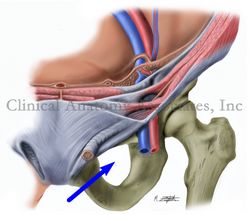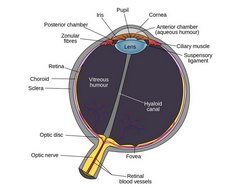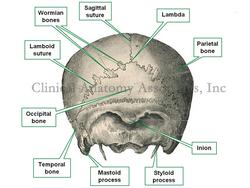
Medical Terminology Daily (MTD) is a blog sponsored by Clinical Anatomy Associates, Inc. as a service to the medical community. We post anatomical, medical or surgical terms, their meaning and usage, as well as biographical notes on anatomists, surgeons, and researchers through the ages. Be warned that some of the images used depict human anatomical specimens.
You are welcome to submit questions and suggestions using our "Contact Us" form. The information on this blog follows the terms on our "Privacy and Security Statement" and cannot be construed as medical guidance or instructions for treatment.
We have 1238 guests online

Georg Eduard Von Rindfleisch
(1836 – 1908)
German pathologist and histologist of Bavarian nobility ancestry. Rindfleisch studied medicine in Würzburg, Berlin, and Heidelberg, earning his MD in 1859 with the thesis “De Vasorum Genesi” (on the generation of vessels) under the tutelage of Rudolf Virchow (1821 - 1902). He then continued as a assistant to Virchow in a newly founded institute in Berlin. He then moved to Breslau in 1861 as an assistant to Rudolf Heidenhain (1834–1897), becoming a professor of pathological anatomy. In 1865 he became full professor in Bonn and in 1874 in Würzburg, where a new pathological institute was built according to his design (completed in 1878), where he worked until his retirement in 1906.
He was the first to describe the inflammatory background of multiple sclerosis in 1863, when he noted that demyelinated lesions have in their center small vessels that are surrounded by a leukocyte inflammatory infiltrate.
After extensive investigations, he suspected an infectious origin of tuberculosis - even before Robert Koch's detection of the tuberculosis bacillus in 1892. Rindfleisch 's special achievement is the description of the morphologically conspicuous macrophages in typhoid inflammation. His distinction between myocardial infarction and myocarditis in 1890 is also of lasting importance.
Associated eponyms
"Rindfleisch's folds": Usually a single semilunar fold of the serous surface of the pericardium around the origin of the aorta. Also known as the plica semilunaris aortæ.
"Rindfleisch's cells": Historical (and obsolete) name for eosinophilic leukocytes.
Personal note: G. Rindfleisch’s book “Traité D' Histologie Pathologique” 2nd edition (1873) is now part of my library. This book was translated from German to French by Dr. Frédéric Gross (1844-1927) , Associate Professor of the Medicine Faculty in Nancy, France. The book is dedicated to Dr. Theodore Billroth (1829-1894), an important surgeon whose pioneering work on subtotal gastrectomies paved the way for today’s robotic bariatric surgery. Dr. Miranda.
Sources:
1. "Stedmans Medical Eponyms" Forbis, P.; Bartolucci, SL; 1998 Williams and Wilkins
2. "Rindfleisch, Georg Eduard von (bayerischer Adel?)" Deutsche Biographie
3. "The pathology of multiple sclerosis and its evolution" Lassmann H. (1999) Philos Trans R Soc Lond B Biol Sci. 354 (1390): 1635–40.
4. “Traité D' Histologie Pathologique” G.E.
Rindfleisch 2nd Ed (1873) Ballieres et Fils. Paris, Translated by F Gross
"Clinical Anatomy Associates, Inc., and the contributors of "Medical Terminology Daily" wish to thank all individuals who donate their bodies and tissues for the advancement of education and research”.
Click here for more information
- Details
The word [ramus] is Latin and means “branch”. The plural form for [ramus] is [rami]. This word is used to denote “branches” or “divisions” in anatomical structures such as:
• Dorsal and ventral rami: the posterior (dorsal) and anterior (ventral) branches or divisions of a spinal nerve.
• Rami communicantes: small nerve connections between the spinal nerve and the sympathetic chain. These tiny nerve branches are part of the autonomic nervous system. Some are present at all levels of the spinal cord (gray rami communicans) and some only at levels T1 through L2 (white rami communicans)
• Pubic rami: the superior and inferior lateral extensions of the pubic bone, which form the superior and inferior boundaries of the obturator foramen (see image)
Image property of:CAA.Inc.Artist:M. Zuptich
- Details
The word [proptosis] is composed of the prefix [pro-] meaning “forward”, the root term [-pt-] from the Greek [πτώση] (ptosi) which meaning “to fall”, and the suffix [-osis] meaning “condition”. Literal interpretation of the term would be “condition of falling forward”. Sometimes [–ptosis] can be considered a suffix, meaning “to sag” or "to droop".
Proptosis is used in medical terminology to describe a forward bulging to the eyes, similar to exophthalmos. The only difference is that the term exophthalmos is usually reserved to forward displacement of the eye related to or secondary to endocrinological dysfunction. All other eye protrusions are referred to as [proptosis
Proptosis can be caused by trauma, localized inflammation of the orbital tissues not related to thyroid dysfunction, tumors, etc.
- Details
The word [exophthalmos] is composed of the prefix [ex-] meaning “outer” or “outside”, the root term [-ophthalm-] which arises from the Greek word [οφθαλμός] (ophthalm?s) meaning “eye”, and the adjectival suffix [-os] meaning “pertaining to”. Literal interpretation of the term would be “pertaining to outside the eye”.
In reality the word [exophthalmos] is used to describe a condition where the eye is pushed anteriorly, protruding or bulging within the eye orbit. This condition can be unilateral or bilateral.
The term exophthalmos is usually reserved to forward displacement of the eye related to or secondary to endocrinological dysfunction. All other eye protrusions are referred to as [proptosis]. More on this word can be read on this article.
Thyroid dysfunction can lead to inflammation of the orbital tissues, including muscle and fatty tissues, causing edema and forward displacement of the eye.
- Details
The root term [-ophthalm-] arises from the Greek word [οφθαλμός] (ophthalm?s) meaning “eye” or "optic". It is used in several medical terms such as:
- Ophthalmology: The suffix [-ology] means “to study”. The study of the eye
- Ophthalmologist: A health care professional who specialized in eye diseases
- Ophthalmic: The adjectival suffix [-ic] means “pertaining to” and can be seen in anatomical terms such as the ophthalmic artery
- Ophthalmitis: The suffix [-itis] means “inflammation” or “infection”.
- Ophthalmoscope: An instrument to view the eye
- Anophthalmia: The prefix [an-] means "without" or "absence of". A congenital condition where one or both eyes do not develop
- Exophthalmos: The prefix [ex-] means "outer" or "outside". A protrusion of the eyes
Image by Rhcastilhos [Public domain], via Wikimedia Commons.
- Details
UPDATED: The root term [-mast-] arises from the Greek [μαστός] or [mastos] meaning "breast". A synonymous prefix is [mamm-] from the Latin [mamma], also meaning "breast". This prefix is used in medical terms such as:
- Mastectomy: The suffix [ectomy] means "removal of". Removal of the breast. This is an old operation, the first known records are from 180 A.D. The modern operation for radical mastectomy with careful removal of the related lymphatics was developed by William Halsted (1852 - 1922). The synonym [mammectomy] is correct, though rarely used. The word [masectomy] to refer to this procedure is incorrect and should not be used
- Mastoptosis: The suffix [-(o)ptosis] means "to fall", "to sag" or "go down". A falling or sagging of the breast. (Syn. mammoptosis)
- Mastoid: The suffix [oid] means "similar to". Similar to a breast or with the shape of a breast, such as the mastoid process, a bony prominence of the temporal bone. See accompanying image
- Mastoplasty: The suffix [-(o)plasty] is used to mean "surgical reshaping". Surgical reshaping of the breast. Better known as a mammoplasty
- Mastopexy: A type of mastoplasty. The suffix "opexy" is used to mean "surgical fixation". Surgical fixation of the breast. In a mastopexy, the breast is "fixed" higher to reduce the mastoptosis. (Syn. mammopexy)
There is an interesting evolution of this word. The above applies only when the term [-mast-] is used as a root term, and combined with other word components. From the Greek, this term was passed on to Latin and thence evolved with the German term [m?sten] meaning "to feed" or "to fatten". This is why we have [mast cells] in histology. These are a type of mononuclear leukocyte described by Paul Ehrlich (1814 - 1915) in 1879, who named them [maztellen], which in German means "a well-fed cell".
For images of mastoptosis and mastopexy, CLICK HERE. Warning: images depict nude bodies.
Sources:
1. "The Origin of Medical Terms" Skinner, HA 1970 Hafner Publishing Co.
2. "Dorland's Illustrated Medical Dictionary" 28th Ed. W.B. Saunders. 1994
3. "Medical Terminology; Exercises in Etymology" Dunmore CW, Fleischer RM 2nd Ed. 1985
4. "Medical Meanings; A Glossary of Word Origins" Haubrich, WS. Am Coll Phys 1997
- Details
UPDATED: The term [fascia] means "band or bandage". It is derived from the Latin word [fascis] meaning "bundle", therefore a fascia is the bandage that ties a bundle. A bundle of sticks tied around an ax was the symbol of the lictors, the Roman imperial bodyguards. Many fasciae (Pl.) are eponymic, such as Camper's Fascia, Scarpa's fascia, Colle's fascia, etc.
In anatomy, the word [fascia] refers to a sheet of connective tissue. The term encompasses many types of fasciae (plural for fascia) which range from the thin deep or muscular fascia to the tendon-like thick fascia lata of the thigh. The image shows the anterior aspect of the thigh and its covering, the fascia lata. The opening shown in the fascia lata is the fossa ovalis of the thigh. Do not confuse with the fossa ovalis found in the interatrial wall of the heart. Click on the image for a larger depiction.
In the extremities, some fasciae may contain more than one muscle, creating fascial compartments. Trauma or vascular pathology in a fascial compartment may cause the muscles to swell to the point that the edema starts causing ischemia compromising the muscles to the point of necrosis. This is called "compartment syndrome" and may require a surgeon to cut open the fascia to relieve the pressure, a procedure called a "fasciotomy". For more information on [-otomy], click on this link.
Original images by Henry VanDyke Carter, MD and links courtesy ofbartleby.com






